Nagaland is a hill state located in the far northeastern part of India. It borders the state of Assam to the west, Arunachal Pradesh and part of Assam to the north, Myanmar to the east and Manipur to the south. The state capital is Kohima, and the largest city is Dimapur. With a population of nearly two million people, it has a total area of 16,579 km. - making it one of the smallest states of India.
Nagaland is largely a mountainous state. The Naga Hills rise from the Brahmaputra Valley in Assam to about 2,000 feet and rise further to the southeast, as high as 6,000 feet. Mount Saramati at an elevation of 12,552level is the state's highest peak - this is where the Naga Hills merge with the Patkai Range in Myanmar. Rivers such as the Doyang and Dhiku to the north, the Barak river in the southwest and the Chindwin river of Myanmar in the southeast, dissect the entire state.
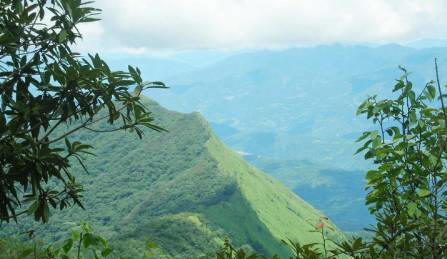
Nagaland is rich in flora and fauna. About one-sixth of Nagaland is underthe cover of tropical and sub-tropical evergreen forests - including palms, bamboo and rattan as well as timber and mahogany forests. While some forest areas have been cleared for jhum - cultivation - many scrub forests, high grass, reeds and secondary dogs, pangolins, porcupines, elephants, leopards, bears, many species of monkeys, sambar, deers, oxen and buffaloes thrive across the state's forests. The Great Indian Hornbill is one of the most famous birds found in the state.
Nagaland has a largely monsoon climate with high humidity levels. Annual rainfall averages around 70-100 inches - concentrated in the months of May to September. Temperatures range from 70 degrees to 104 degrees fahrenheit. In winter, temperatures don't generally drop below 39 degrees fahrenheit, but frost is common at high elevations.

The tribes of Nagaland are Lothas, Angami, Ao, Chakhesang , Chang, Khiamniungan, Konyak, Phom, Pochury, Rengma, Sumi, Sangtam, Yimchungru, Tangkhul, Zeliang of which the Angamis, Aos, Lothas and Sumis are the largest Naga tribes. Tribe and Clan traditions and loyalties plays an important part in the life of Nagas. Weaving is a traditional art handed down through generations in Nagaland. Each of the major tribes has its own unique designs and colors, producing shawls, shoulder bags, decorative spears, table mats, wood carvings and bamboo works. Tribal dances of the Nagas give an insight into the inborn reticence of the people. War dances and dances belonging to distinctive tribes are a major art form in Nagaland. Some of these are Moatsu, Sekrenyi, Tuluni and Tokhu Emong. More than 80% of the people live in rural areas. Nagas speak 60 different dialects belonging to the Sino-Tibetan family of languages. Nagamese, a variant language form of Assamese and local dialects is the most widely spoken market language. One interesting part is every tribe has their own mother tongue language and these tribes communicate with each other in Nagamese. As such Nagamese is not a mother tongue of any of the tribes and nor is it a written language. English, the official state language is widely spoken in official circles and is the medium for education in Nagaland.

ANGAMI
The Angami's celebrate SEKRENYI in the month of February. It normally falls on the 25th day of the Angami month of KEZEI. The ten-day festival is also called PHOUSANYI by the Angami's. The festivals follows a circle of ritual and ceremony, the first being “KIZIE”. followed by “DSUSEVA” (touching the sleeping water) sacrifices are also made during this time.
The THEKRA HIE is the best part of the festival where the young people of the village is sit together and sing traditional songs throughout the day. Jugs of rich-beer and plates of meat are placed before the participants. On the seventh day the young men go for hunting. The most important ceremony falls on the eighth day when bridge-pulling or gate pulling is performed or inter-village visits are exchanged. Until the close of the festival, no one goes to fields and all field work cease during this season of feasting and song.
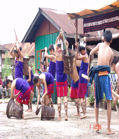

AO
The Aos observe Moatsü Mong after the sowing is done. It provides the Aos a period of recreation after the strenuous job. The festival marked by vigorous songs and dances merry making and fun is now observed only for three days from 1-3 May. During this festival one of the symbolic celebrations is SANGPANGTU where a big fire is lit and men and women sit around it.
The women serve the best wine and meat they can prepare. Aos have another festival called TSUNGREM MONG celebrated on the eve of harvest. However, nowadays the Aos celebrated this festival from 1 to 3 August. These festivals provide opportunities to the building generation and village stalwart to demonstrate their intellectual skill and physical powers.
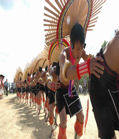
CHAKHESANG
The Chakhesang community celebrated seven festivals in year as shown below: SUHKRUHNYE - 15th January, NGUNYE - 1st February, TSAKRONYE - 1st Sunday of March 4, TSUKHANYE / TSUKHENYIE - 6th May, KHUTHONYE - 15th July, TURHINYE - 25th August, THURINYE / KHILUVATU - 1st December. SUHKRUHNYE is the most important festival.
During this festival the boys and girls are sanctified through religious ceremonies and rituals. “SUHKRUHNYE” covers eleven days. TSUKHENYE festival is also an important festival for the Chakhesang. Earlier it was usually celebrated at the end of the 3rd lunar month of March. But now it is being observed on 16th May. TSUKHENYE is a festival which celebrates the culmination of all leisure activities and a festival for welcoming a new fruitful life and year.
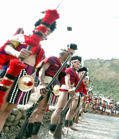
CHANG
The Chang usually observe six major festivals in year, out of which three festival namely Poang Lem, Jeinyu Lem, Kundang Lem were monitored by Haongang Clan. The remaining three festivals Muong Lem, Naknyu Lem, Monyu Lem were monitored by Ung Clan. In this way the tradition was maintained for generations and is followed till date.
All festivals were fixed six days ahead except the KUNDANG LEM and NAKNYU LEM. The Kundang Lem was treated as the youngest and was fixed five days ahead, the Naknyu Lem was treated with much awe and so was fixed just two days ahead. Kundang Lem is observed in the eighth month (April) of the Chang Calendar. This festival is observed for five days. NAKNYU LEM is held on the eleventh month of the Chang Calender which falls during July.

KACHARI
The Kacharis celebrates a number of festivals in a year. Amongst them the most important ones are (a) Bushu or Bushu Jiba which is widely celebrated by the Dimasa kacharis and (b) Baisagn – the spring festival of the Mech (Boro) Kacharis. The Bushu is basically a post harvest festival and usually falls in the month of January every year after the hard earned grains of paddy are harvested, thrashed and stored ion the granaries.
1. Hangsho – Which lasts for 7 days and 7 nights.
2. Surem – Lasts for 3 days and 3 nights.
3. Jidep Jiba – Lasts for 1 day and 1 night.

KHIAMNIUNGAM
MIU is held in the first week of May every year. One of the main significances of this festival is to build cordial relations and to forge close-knit relations between the maternal uncle and his sister’s off-springs. It is also a very special occasion of FORGIVE and FORGET. This festival is also known as dividing line between merrymaking season and the start of working season.
From this festival people stop performing folk songs and dance till the next joyous festival called ‘TSOKUM’. TSOKUM is held during the first week of October. It is mainly observed to give thanks to the Almighty Deity for giving good crops and safeguarding lives in the family.
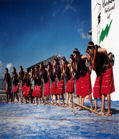
KONYAK
The entire Konyak Community of Nagaland, observe Aoleang Monyu in the first week of Aoleang Lee (April) every year since time immemorial. Aoleang is observed after completion of the new year beginning with spring when a riot of flowers in every hue start to bloom. It is a time to ask Almighty God for bountiful harvest of crops in that very year. The Aoleang Monyu is spread over six days.
Each day has separate name and different significance; Hoi Lai Yah Nyih, Yin Mok Pho Nyih, Yin Mok Shek Nyih, Lingnyu Nyih , Lingha Nyih and Lingshan Nyih.
KUKI
Mimkuut is the harvest festival of the Kukis, Kukis of Nagaland celebrate this festival on the 17th Kuki month of Tolbol (January) every year. The celebration lasts one week. Besides, Mimkuut, Kukis celebrate Chapphou Kuut and Chavang Kuut as well as other smaller festivals. It is believed that Mimkuut and other festivals came into being from the fact that, in order to appease Thilha (demon).

LOTHA
The Tokhu Emong is the harvest festival of the Lothas. Tokhu Emong is celebrated in the 1st week of November every year and it stretches over to 9 days. Earlier, no particular date was fixed. However, in order to carve unity and uniformity among the ranges, Wokha elders decided to celebrate on November 7, every year. The main features of the feast are community songs, dances, feast fun and frolic.
Tokhu Emong is also festival of thanksgiving, sharing and reconciliation but the most beautiful aspect of this festival is that past rancor's are forgiven, new ties are formed and bonds of closer intimacy are formed.
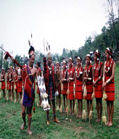
PHOM
The Phoms have four major festivals each having unique significance. There are MONYU, MOHA, BONGVUM and PAANGMO. Monyu, the most popular and biggest festival falls in the month of April every year soon after the sowing season. The festival is celebrated for six days beginning from 1st to 6th April every year. It also marks the end of winter and the beginning of summer of monsoon.

Monyu is the time to bid farewell to the past year and herald the dawn of the new year. It is also the time of prayers and dedication for the sprouting crops that are sowed. Moha is the one day festival in the month of May to pray for the better growing of seeds/plants. The Bongvum festival generally falls in the month of October every year after the major harvest and is observed only for a day. This festival may be best interpreted as the festival of Thanksgiving to the unseen Almighty God. Paangmo is another important event of the Phoms. It is celebrated in the month of November which stretches over three days.
POCHURY
October is the month of festivity which every Pochury anxiously awaits, ever year to celebrate their greatest festival Yemshe. Yemshe is the festival of welcoming the new harvest and blessings. All the Pochuries, young and old, rich and poor, celebrate the festival with great pomp and gaiety anticipating a good harvest. Yemshe is celebrated on 5th October every year.
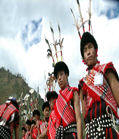

RENGMA
The Rengmas celebrate eight days of Ngadah festival towards the end of November just after harvest. it is the festival of thanksgiving, merrymaking and rejoicing. This festival also marks the end of the year. Ritual are performed along with feasting, dancing, singing to mark the festival.
SANGTAM
The Sangtams have about 12 festivals spreading over the year including some special functions. Except for certain Gennas, all the festivals are concerned with food production, blessings and prosperity. AMONGMONG is one of the most important festivals of the Sangtams. The predominant theme of the festival is the worship of God of the house and the three cooking stones in the fire place.

The festival is observed in the first week of September every year. AMONGMONG festival means togetherness and stretches for six days. The object is to have a good harvest.
SUMI
Ahuna is a traditional post harvest festival of the Sumis. Ahuna signifies the celebration of the seasons harvest's in thanksgiving, while evoking the spirits for good fortune in the New Year Tuluni is a festival of great significance. the festival is marked with feast as the occasion occurs in the bountiful season of the year.
Drinking rice beer indispensably forms a part of the fest. This wine is called TULUNI. It is celebrated in mid July every year.
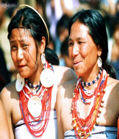
YIMCHUNGER
The Yimchungrüs celebrate Metumniu festival from 4th to 8th August every year. This festival is connected with prayers for the souls of the departed ones. The festival is spread over five days and has separate names for the days, SHITO, ZHIHTO, ZUMTO, KHEHRESUK, SHERESUK. The festival also has strong agricultural base and the agricultural implements are sharpened and worshipped.
Another important festival of the Yimchungrüs is Tsungkamniu, it falls in the month of January and is celebrated from 14th to 16th every year. This festival is observed to signify the year long life and harvest achieved during the year long hard work in the fields.
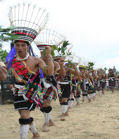
ZELIANG
The Hega festival is one of the most important festivals among the Zeliang people.It falls in the month of February from 10th to 15th every year. It is a festival invoking the Almighty God to shower his blessings upon his people with richness, luck and courage. It is also a festival of joy, rest and togetherness. The festival lasts for five days. Chega Gadi is another important festival of the Zeliangs.
The genesis of the this festival marks the peoples belief that on this day the Almighty showers blessings and brings good harvest and health. However the date for the celebration differs between villages and communities. The forefathers observed this festival for a duration of 4-5 days. Now it is celebrated for 3-4 days.
The Nagas have a rich tradition of art and craft rooted in a lifestyle that has always been harmony with the environment they live in. Skilled tribal craftsman and artisans have always been the pillars of a tribal society that had, for many centuries, been self-sufficient. They lent their skills to creating items of utility as well those with ritualistic and aesthetic value. To quote Dr. Verrier Elwin; “they have made their own cloth, their won hats and rain-coats; they have prepared their own medicines, their own cooking-vessels, their own substitutes for crockery... “ Skilled craftsmen were employees to carve splendid village gates, house posts and Morungs in Naga villages. Fine storage baskets, wicker drinking vessels and containers were woven by craftsmen whose skills had been inherited from generations of skilled craftsmen.
It was these craftsmen, weavers and artisans who foraged the forest in search of wood, barks, dyes and other resources that were utilized to carve out fine works of art and weave colorful clothes that distinguished each Naga tribe.
The various crafts and art that were known to the early Nagas and are still carried out to this day are;

1) Basketry : Naga storage and carry baskets women from fine strips of cane and bamboo are well known and soughtafter for their utility as well as aesthetic value. The cane baskets of Khonoma village are particularly well know for theirintricate weaves. The cane baskets and containers woven by the Khiamngan weavers in the Tuensang District are also known for their fineness and delicacy of work that gives it a lace-like appearance. Headgears and mats are also woven from fine bamboo and cane strips. In the recent years, entrepreneurs have utilized the skills of these craftsmen to weave beautiful cane furniture that are being marketed in the local as well as outside market.
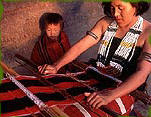
2) Weaving: Naga women are excellent weavers and the colorful shawls, bags and jackets woven by them are extremely popular. The ‘backstrap’ or the loin loom is commonly used for weaving, although, in recent years the fly shuttle loom has become popular with the weavers. Each tribe uses distinguishing colors and motifs that are often based on tribal folklore. Earlier, natural dyes extracted from barks, roots and plants were used for dyeing cotton yarn and woven fabrics. In addition, woven cloth was embellished with beads, cowrie shells and goats hair to denote the wealth and status of the weaver. Body cloth symbolizing Feast-giving and Head-taking added to the variety of clothes woven on the backstrap loom.
The art of weaving is still popular amongst the Naga women, especially in the rural areas and the woven products of Nagaland have found its way into the National as well as International marker.
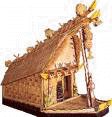
3) Woodcarving : Nagas are excellent woodcarvers. Making using of simple rudimentary tools and implements such as the local dao, hand drill and chisel, skilled craftsmen produce great works of art that local adorn village gates and house posts as well as objects of utility like the common wooden dish. One of the finest specimen that epitomizes the skill of the Naga craftsman is to be found at Shangnyu village in Mon District. The work of art at Shangnyu consists of a massive wooden panel that has carvings depicting objects of art as well as those of ritual and utility value.
Woodcraft has now been commercialized and craftsmen have been able to use their traditional skills to generate income for themselves. The Diezephe Craft village in Dimapur District is a good example of a cragft concentrated village where the major sourse of income is from woodcraft.

4) Pottery : Pottery was known to the early Nagas and was mostly done by the womenfolk. The pots made were generally very simple and importance was given to its functional value rather than aesthetics. Tseminyu and Ungma village were well known for pottery by aluminum and steel vessels have long replaced the simple clay pots.

5) Metal work : Iron tin and brass were used to produce weapons as well items of utility and ornaments. The Konyak blacksmiths were famous for their works in the early days and their products were in great demand in the plains of Assam. To this day, the local dao, spears, chisels, ornaments and other items of utility are still made by local blacksmith whose skills are highly valued in society.
In addition, jewellery and beadwork is also popular with local craftsmen. Naga festivals are a testimony to the fascination and love the Naga tribesmen have for art and craft. The color and beauty of the traditional attires symbolize the wealth and status of the wearer as well as the skill of the maker. The abundance of raw material, the splendid environment and the inherent skills of the people have all played a role in generating a rich history of art and craft in Nagaland. The resurgence of art and craft in recent times has enable the traditional craftsman and artisan to earn as he creates.

Kohima
The Capital : Perched at 1444.12 metres above sea level, Kohima enjoys a temperate climate throughout the year. The two hour drive from Dimapur to Kohima can be an enjoyable experience. You could treat yourself to a hot hearty meal of local cuisine from one of the typical Naga wayside amenities that line the road at regular intervals. The panoramic view of Kohima unfolds at 16 kms from your destination, nestled among the pristine hills.
Kohima War Cemetery
Kohima War Cemetery offers a space for a quiet moment of a contemplative stroll with friends & family. This is a symbolic memorial raised as a citation for the supreme sacrifices made by the officers and men of the allied forces, to halt the tide of the Japanese onslaught during the Second World War. This was their last post. The cemetery is beautifully and meticulously maintained by the Commonwealth War Graves Commission.

State Museum
For the tourists, there are historical artifacts, log drums, tools & implements, old Naga currencies, attire of warriors, dresses & costumes all preserved here. This museum provides a bird's eye view of the fifteen colourful tribes at close quarters.
Dzukou Valley
This valley is tucked away at 2438 metres above sea level. From June to September, the entire valley is covered with a carpet of wild flowers. Here, you are completely at peace with nature. The valley is surrounded by hills, natural caves & rocks ideal for camping.
Japfu Peak
Scaling the Japfu peak at 3048 metres above sea level can be very trying, but exhilarating. Once up, the expansive vista of nature's beauty more than compensates the effort put in. The range gets covered by mist at the break of dawn, adding to its mystic beauty.
Khonoma
This place offers a peep into the village lifestyle of the people here. This village is not only laced in history but also known for its ecological propriety. The terraced fields carved out from the hill top to the lower valley, present an interesting study. You can always hear fascinating stories of folklore here from the villagers.
Kohima Village
Considered to be one of the largest in Asia, a traditional gate greets the visitor.There are stones of varying shapes and sizes implanted within the compound or skulls of buffaloes and mithuns adorning the portico, reminding you of the past glory and status of the great ancestors.
Zoological Park
This place offers you a glimpse of the fauna of Nagaland. The rare Blythe's Tragopan believed to be on the verge of extinction, is being reared here in captivity. Rare species of Orchids can also be seen here.
Dzulekie
This is an enchanting place near Kohima, where domesticated bisons roam freely in pastoral ambience. The surrounding green hills and little waterfalls thrown in, add to the pleasure to being in this cool getaway.

Dimapur
On the way to Kohima, this site was the first headquarter, established by the British. The Triple Falls located in Seithekima village area, is another resort being developed by the Department of Tourism. As the name suggests, it is a three-tier waterfall, cascading from a height of 280 feet into an inviting natural pool. Dimapur was the ancient capital of Kachari Kingdom. A small footprint of the megalithic culture still exists.
Intanki Wildlife Sanctuary
Intanki Wildlife Sanctuary is just 37 kms away from Dimapur. It is the habitat of various animals and rare species of birds.
Ruzaphema
It is a place, ideally suited for leisure and recreation with its colourful bazaars and a wide range of tribal handicrafts, which are exquisite in their style.
Fakim Sanctuary
This sanctuary, close to the Myanmar border is inhabited by tigers & Hoolock gibbons and recieves high rainfall.
Pulie Bazde
Another sanctuary, Pulie Bazde lies in close proximity of Kohima.
Get Best Deals Directly in Your Inbox Today !
You will get notification for every deal as it appears
